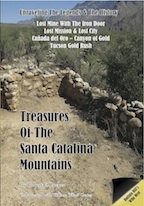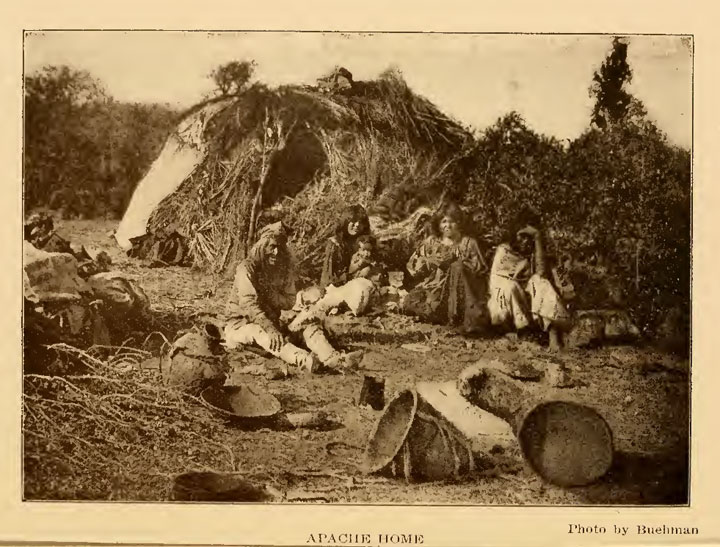But the one great drawback to
civilization and progress in Arizona was the Apache Indian. He was the
omnipresent evil, and like some people who are never so happy as when
they are miserable, so, the dreaded Apaches were always at war— even in
times of expected peace— stealthy, treacherous, greedy, too lazy to earn
a livelihood except by thievery, they were a constant menace to
civilization from any source— toward any direction.
They could tell you in a trice if any
injustice were attempted toward them, but utterly callous, blood-thirsty
and cruel. You would think, if there were not so many of them, that his
Satanic majesty had taken possession of them, and there was plenty of
him to go around. It was mostly their constant attacks upon the
Pima tribes of Arizona that in 1751,
about sixty years after the founding of the prosperous missions, drove
the naturally resentful Pimas to revolt, for they knew no release from
the harassments of the merciless foe, and driven to madness, they
rebelled; many of the priests were killed, and several of the missions
were destroyed.
After this insurrection the vice-regal
government erected the presidios of Tucson and Tubac, and maintained
therein small garrisons for the protec- tion of the missions.
In 1765 a royal decree from Madrid
ordered the expulsion of the Jesuits from Spain and her colo- nies, but
as the order was not carried into immedi- ate effect, it was 1767 before
they left this country. The results of this expulsion, however, were so
severe that the Arizona missions never recovered from the blow, though
in the following year, 1768, fourteen Franciscan friars arrived in
Tucson from Mexico, to take the places of the banished Jesuits. Yet a
Steady decline of the missions followed and in 1828, by order of the
Mexican government, the missions were entirely abandoned; the colonies
were despoiled by the savages, and the few escap- ing the barbarians,
took refuge in the presidios. By the close of the Mexican War, 1847,
these terrible Apaches had driven from what was then called Pimeria
Alta, almost every vestige of civilization, and years of precarious
living for the presidios of Tucson and Tubac followed. A temporary
chapel in the presidio, in the early days, was dedicated to the use of
the military and its few other occupants.
The town was walled for many years,
probably not less than one hundred and fifty, and was built in the form
of a square, the wall rising about five feet above the flat roofs of the
houses, affording fine breastworks for the defense of the Pueblo; the
rear end of the houses was built into, and against the heavy wall
surrounding the little settlement. The only door allowed was the one
opening into the open square in front. The flat roofs, in the summer
time, furnished fine family sleeping rooms.
The little fort was also built in the
form of a square, with a tower at each corner, fitted with loop- holes
or small windows for outlooks, and for firing on the raiding Indians.
The old records say that several times the wild Apaches made well
organized and desperate attempts to capture Tucson, under their bravest
and ablest leaders, and over one thous- and. ra-rriors strong, but they
were always repulsed, Tucson, being the most northerly of the Spanish
set- tlements, was a constant check upon those cruel Indian raids, which
often penetrated even northern Old Mexico.
One authority claims that in 1800 Tucson
was garrisoned by about one hundred regular Spanish soldiers, and
consisted of one hundred and fifty adobe houses, with a population of
three hundred and fifty, nearly all of whom must have been Mexicans and
Indians.
During the Mexican war, or near its
close, a small force of Texan soldiers captured the little town of
Tucson, but being pressed for time did not take the fort. The Mexican
commander, when making his Off-Kai iteportto his government,
congratulated himself upon his victory,
These pages on Tucson history are from the book "Old Tucson; a hop, skip and jump" by Estelle M. Buehman available on Amazon.
by Estelle M. Buehman available on Amazon.
Local Tucson Books
 "Treasures of the Santa Catalina Mountains,"
by Robert Zucker. The legends and history of the Catalinas– the Tucson
Gold Rush, the Iron Door Mine, Buffalo Bill's mining camp, and the story
of mining the mountains for gold, silver and copper. Read chapters
online, download a free sample PDF of the book and purchase on
Amazon. "Treasures of the Santa Catalina Mountains,"
by Robert Zucker. The legends and history of the Catalinas– the Tucson
Gold Rush, the Iron Door Mine, Buffalo Bill's mining camp, and the story
of mining the mountains for gold, silver and copper. Read chapters
online, download a free sample PDF of the book and purchase on
Amazon. |
 "Entertaining Tucson Across the Decades,"
by Robert Zucker. Covers the local music and entertainment scene from
the 1950s through the end of the 20th Century. Interviews with local
musicians, original photographs and stories published in local
newspapers. Read chapters online, download a free sample PDF of the book
and purchase on Amazon. "Entertaining Tucson Across the Decades,"
by Robert Zucker. Covers the local music and entertainment scene from
the 1950s through the end of the 20th Century. Interviews with local
musicians, original photographs and stories published in local
newspapers. Read chapters online, download a free sample PDF of the book
and purchase on Amazon. |
© 2010-2019. EMOL.org. All rights reserved
 "Treasures of the Santa Catalina Mountains,"
by Robert Zucker. The legends and history of the Catalinas– the Tucson
Gold Rush, the Iron Door Mine, Buffalo Bill's mining camp, and the story
of mining the mountains for gold, silver and copper. Read chapters
online, download a free sample PDF of the book and purchase on
Amazon.
"Treasures of the Santa Catalina Mountains,"
by Robert Zucker. The legends and history of the Catalinas– the Tucson
Gold Rush, the Iron Door Mine, Buffalo Bill's mining camp, and the story
of mining the mountains for gold, silver and copper. Read chapters
online, download a free sample PDF of the book and purchase on
Amazon.  "Entertaining Tucson Across the Decades,"
by Robert Zucker. Covers the local music and entertainment scene from
the 1950s through the end of the 20th Century. Interviews with local
musicians, original photographs and stories published in local
newspapers. Read chapters online, download a free sample PDF of the book
and purchase on Amazon.
"Entertaining Tucson Across the Decades,"
by Robert Zucker. Covers the local music and entertainment scene from
the 1950s through the end of the 20th Century. Interviews with local
musicians, original photographs and stories published in local
newspapers. Read chapters online, download a free sample PDF of the book
and purchase on Amazon.